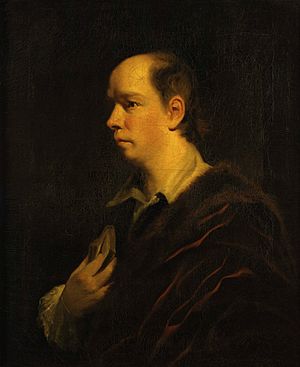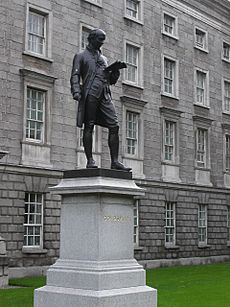Oliver Goldsmith facts for kids
Quick facts for kids
Oliver Goldsmith
|
|
|---|---|

Portrait 1769–70 by Joshua Reynolds
|
|
| Born | 10 November 1728 Either Ballymahon, County Longford, Kingdom of Ireland, or Elphin, County Roscommon, Kingdom of Ireland |
| Died | 4 April 1774 (aged 45) London, England |
| Resting place | Temple Church, London |
| Occupation | Playwright, poet, busker, apothecary's assistant |
| Language | English |
| Education | Trinity College, Dublin (B.A., 1749) University of Edinburgh (M.D., 1755) |
| Literary movement | The Club |
| Notable works |
|
| Signature | |
Oliver Goldsmith (born 10 November 1728 – died 4 April 1774) was a famous Anglo-Irish writer. He wrote novels, plays, and poems.
He is best known for his novel The Vicar of Wakefield (1766). His poem The Deserted Village (1770) and plays like She Stoops to Conquer (1773) are also very popular. Some people believe he wrote the classic children's story The History of Little Goody Two-Shoes (1765).
Contents
About Oliver Goldsmith
Early Life and Education
Oliver Goldsmith's exact birth date and place are not fully known. He was likely born on 10 November 1728. His birthplace was either near Ballymahon in County Longford or near Elphin in County Roscommon, Ireland. His father was a clergyman.
When Oliver was two, his family moved to Lissoy in County Westmeath. They lived there until his father passed away in 1747.
In 1744, Oliver started studying at Trinity College, Dublin. He didn't focus much on his studies in religion and law. He graduated in 1749 with a Bachelor of Arts degree. However, he didn't have a clear path for a career in the church or law. He enjoyed nice clothes, playing cards, singing, and playing the flute.
After college, he lived with his mother for a short time. He tried different jobs but didn't find much success. From 1752 to 1755, he studied medicine at the University of Edinburgh. Then, he traveled through Europe, including France and Switzerland. He often earned money by playing his flute.
Life as a Writer in London


In 1756, Oliver settled in London. He worked various jobs, like helping in a pharmacy and teaching at a school. He often struggled with money.
He became a very busy writer, creating many works for publishers in London. His hard work helped him become friends with famous people like Samuel Johnson. Goldsmith was a founding member of "The Club," a group of important writers and thinkers.
Friends described Goldsmith as a fun and friendly person. He was very kind and loved being around children. He wasn't always careful with his money, often spending it or giving it away. Samuel Johnson greatly admired Goldsmith's writing talent.
Later Life and Legacy
Oliver Goldsmith was known for being cheerful but also a bit disorganized. He once planned to move to America but missed his ship! He worked at Thornhill Grammar School, and later used some of his experiences there in his novel The Vicar of Wakefield.
He died in 1774 at a relatively young age due to illness. He was buried in Temple Church in London. A monument was later placed in Westminster Abbey with words written by Samuel Johnson.
Among his papers, a plan for a huge encyclopedia was found. He wanted it to be like the French Encyclopédie but for Britain. Famous writers and thinkers were supposed to contribute. However, the project was never finished because of Goldsmith's death.
Famous Works
The Citizen of the World
In 1760, Goldsmith started writing a series of letters for a newspaper called the Public Ledger. These letters were titled The Citizen of the World. They were supposedly written by a Chinese traveler named Lien Chi who was visiting England.
Through this fictional traveler, Goldsmith made funny and thoughtful comments about British society and how people behaved. This series was inspired by an earlier work called Persian Letters.
The Hermit
Goldsmith wrote this romantic poem in 1765. It tells the story of Edwin, a young man without much money, and Angelina, a lord's daughter. Angelina loves Edwin but doesn't show it. Edwin becomes sad and leaves to live as a hermit.
One day, Angelina visits his hermit's home, dressed as a boy. She doesn't recognize him and tells him her story. Edwin then reveals who he is, and they stay together forever. The poem shows a hermit who loves nature but is also kind to others. This poem is also part of Goldsmith's novel, The Vicar of Wakefield.
The Deserted Village
In the 1760s, Goldsmith saw an old village being torn down. Its farms were destroyed to create a large garden for a rich person. His poem The Deserted Village, published in 1770, shares his worry. He feared that destroying villages and turning farmland into fancy gardens would harm the poor farming families.
Other Writings
Oliver Goldsmith wrote many other books, including:
- The Life of Richard Nash (1762)
- The History of England (1771)
- An History of the Earth and Animated Nature (1774)
He is sometimes believed to have written the children's story The History of Little Goody Two-Shoes.
Religious Views
Goldsmith was a member of the Anglican Church. He once famously said that he trusted his priest for his religion, just as he trusted a shoemaker for his shoes. He believed in God and respected Christian teachings.
Memorials to Oliver Goldsmith

Many places and things are named after Oliver Goldsmith:
- In London, there's an Oliver Goldsmith Primary School and streets named after him.
- The Oliver Goldsmith Summer School is held every June in Ballymahon, Ireland, near his birthplace.
- A statue of him stands at Trinity College, Dublin, where he studied.
- Another statue is at the ruins of his birthplace in Pallas, Ireland.
- A new lecture hall and student housing at Trinity College are called Goldsmith Hall.
- The city of Auburn, Alabama, and Auburn University in the USA were named after the first line of his poem: "Sweet Auburn, loveliest village of the plain."
- Auburn in Sydney, Australia, was also named after "Sweet Auburn."
- A statue of him stands in Ballymahon, County Longford, Ireland.
- A London Underground train was named Oliver Goldsmith.
- The library at Athlone Institute of Technology is called the Goldsmith Library.
- Goldsmith Street in Dublin was renamed after him in 1870.
See also
 In Spanish: Oliver Goldsmith para niños
In Spanish: Oliver Goldsmith para niños

